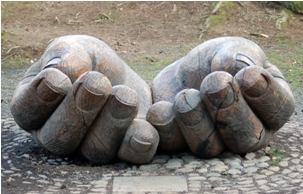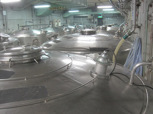 In Praise of "Big Hands" ... Sorta In Praise of "Big Hands" ... Sorta
A bit about the largest brewers
I have defended them before: the "Big Hands" of the industry. And it seems
time to do it again, albeit with a caveat or three.
O-te, (say “oh-teh”) means “big hand,” and it refers to the biggest companies in an industry, so in  this case, the largest brewers, the national brands available everywhere across Japan. These are brands that are ubiquitous, and have made themselves available in every nook and cranny of the world, much to the dismay of tiny local brewers that can no longer sell well even in their own backyards. In terms of numbers, we are talking about 15 to 25 companies. this case, the largest brewers, the national brands available everywhere across Japan. These are brands that are ubiquitous, and have made themselves available in every nook and cranny of the world, much to the dismay of tiny local brewers that can no longer sell well even in their own backyards. In terms of numbers, we are talking about 15 to 25 companies.
But the real truth is that they are more than a bit maligned. Some of the stories I have heard of folks in the overseas sake industry refusing to even try sake from those companies - or dissing the products without having tasted them - demonstrate that misplaced malice and have prompted me to write this at this time.
What’s to defend? Plenty. Sure, they make cheap, bottom shelf sake that  deserves criticism. But they also make some absolutely wonderful sake, and at great prices. The point is that they can make whatever they want. Note too, almost every other brewer makes cheap sake as well, so it is hardly fair to blast the Big Hands simply because they make more of it! deserves criticism. But they also make some absolutely wonderful sake, and at great prices. The point is that they can make whatever they want. Note too, almost every other brewer makes cheap sake as well, so it is hardly fair to blast the Big Hands simply because they make more of it!
And their economies of scale ensure their pricing is very, very competitive. Be it a junmai, a honjozo, or a ginjo, you will find outstanding values in most large brewers’ products at almost any level.
On top of that, they have contributed so much to the industry. These are the companies that designed methods and equipment that are now standard at all breweries, allowing even the smallest to make sake with just a few people. Several rice strains and yeast strains have come to the industry through big brewers, either directly or indirectly. And I have heard from more than one toji of a small brewery that when they get in a bind, they call their connections at the big breweries for “technical support.” And they don’t get put on hold!
It used to be that these were the sake that had the absolute highest reputation. Just 30 years ago even, at the year-end gift giving season, it was far more common to send sake of dependable and stable quality from one of the reputable large breweries than to take a chance on a local brewer that might be better off for cooking, at best. Or so thought many consumers.
 Sure, it’s not all rosey with ‘em; not everything leaves us with warm-n-fuzzy feelings. They also keep prices too low amidst their own price wars, and those bottom-shelf products end up influencing prices up the line. Far, far too often this means that other brewers cannot charge enough to even make a profit. And yes, they have taken away local markets of futsuu-shu from the brewers in the ‘hood. But again, I think they call that competition, and show me a company that doesn’t engage in competition and I will show you a book with only one chapter: eleven. Sure, it’s not all rosey with ‘em; not everything leaves us with warm-n-fuzzy feelings. They also keep prices too low amidst their own price wars, and those bottom-shelf products end up influencing prices up the line. Far, far too often this means that other brewers cannot charge enough to even make a profit. And yes, they have taken away local markets of futsuu-shu from the brewers in the ‘hood. But again, I think they call that competition, and show me a company that doesn’t engage in competition and I will show you a book with only one chapter: eleven.
There are other valid complaints: but they depend on your take on things, what ticks you off, and what you value. F’rinstance, one small brewer recently told me that what leaves him with a bad taste in his mouth is that the big brewers basically dryly assess markets and engineer products from an economic analysis. “If we make a junmai-shu for this price that tastes something along these lines, and that will sell at this chain of stores with a brown label and a gimmick of this type, we will make exactly this much money…”
Says my brewer buddy, “That ain’t brewin’; that ain’t no craft. That’s just precision surgery.” True, true; and if that is your figure of merit then you are right. But it still fills a market need - good products at a fair price - for which there are grateful consumers.
 It also might be fair to say that due to the need to appeal to such a wide range of people, many of their products are conservative, with less idiosyncrasies and liveliness to talk about or love or hate. Then there is the practice of closing out competition by paying restaurants to dominate their menus. And a million other things like that. But hey, one man’s dirty tricks are another man’s clever marketing; who are we to judge! It also might be fair to say that due to the need to appeal to such a wide range of people, many of their products are conservative, with less idiosyncrasies and liveliness to talk about or love or hate. Then there is the practice of closing out competition by paying restaurants to dominate their menus. And a million other things like that. But hey, one man’s dirty tricks are another man’s clever marketing; who are we to judge!
So yeah, there are things about which we can complain, and yeah, the Big Hands are not likely angels. But to me what is unfair and inappropriate is to summarily dismiss from consideration a sake simply because it is from a Big Hand brewer, or to assume that if it has a Big Hand name on the label, it will be bad. Or even to think it less glamorous or somehow less enjoyable because of the scale of the producer. Regardless of business practices or market realities, that’s not fair - and is in fact simply incorrect.
So drink the sake, not its label, and assess it on what you taste and smell. And if you choose to form assessments about the Big Hands, let them be informed and based upon your own figures of merit. Just remember there are two sides to the story, and to taste the stuff first. You might actually like it! |